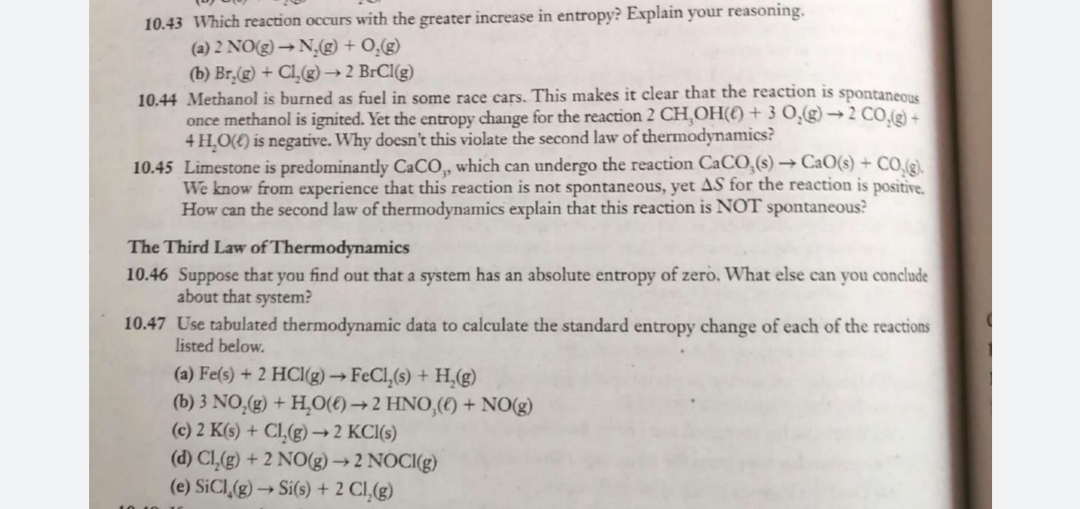Chemistry for Engineering Students
4th Edition
ISBN:9781337398909
Author:Lawrence S. Brown, Tom Holme
Publisher:Lawrence S. Brown, Tom Holme
Chapter10: Entropy And The Second Law Of Thermodynamics
Section: Chapter Questions
Problem 10.80PAE
Related questions
Question
Answer for 10.43 and 10.47 (b)

Transcribed Image Text:10.43 Which reaction occurs with the greater increase in entropy? Explain your reasoning.
(a) 2 NO(g) → N,(® + 0,(g)
(b) Br,(g) + Cl,(g)→ 2 BrCl(g)
10.44 Methanol is burned as fuel in some race cars. This makes it clear that the reaction is spontaneous
once methanol is ignited. Yet the entropy change for the reaction 2 CH,OH(€) + 3 O;@) → 2 CO,(g) +
4 H,O(E) is negative. Why doesn't this violate the second law of thermodynamics?
10.45 Limestone is predominantly CaCO,, which can undergo the reaction CaCO,(s) → CaO(s) + CO,(g).
We know from experience that this reaction is not spontaneous, yet AS for the reaction is positive.
How can the second law of thermodynamics explain that this reaction is NOT spontaneous?
The Third Law of Thermodynamics
10.46 Suppose that you find out that a system has an absolute entropy of zerò. What else can you conclude
about that system?
10.47 Use tabulated thermodynamic data to calculate the standard entropy change of each of the reactions
listed below.
(a) Fe(s) + 2 HCI(g)→ FeCl,(s) + H,(g)
(b) 3 NO,(g) + H,0(E) → 2 HNO,(€)+ NO(g)
(c) 2 K(s) + Cl,(g) → 2 KC(s)
(d) Cl,(g) + 2 NO(g) → 2 NÓCI(g)
(e) SICI,(g) → Si(s) + 2 CI,(g)
Expert Solution
This question has been solved!
Explore an expertly crafted, step-by-step solution for a thorough understanding of key concepts.
Step by step
Solved in 2 steps

Knowledge Booster
Learn more about
Need a deep-dive on the concept behind this application? Look no further. Learn more about this topic, chemistry and related others by exploring similar questions and additional content below.Recommended textbooks for you

Chemistry for Engineering Students
Chemistry
ISBN:
9781337398909
Author:
Lawrence S. Brown, Tom Holme
Publisher:
Cengage Learning


Chemistry for Today: General, Organic, and Bioche…
Chemistry
ISBN:
9781305960060
Author:
Spencer L. Seager, Michael R. Slabaugh, Maren S. Hansen
Publisher:
Cengage Learning

Chemistry for Engineering Students
Chemistry
ISBN:
9781337398909
Author:
Lawrence S. Brown, Tom Holme
Publisher:
Cengage Learning


Chemistry for Today: General, Organic, and Bioche…
Chemistry
ISBN:
9781305960060
Author:
Spencer L. Seager, Michael R. Slabaugh, Maren S. Hansen
Publisher:
Cengage Learning

Chemistry: An Atoms First Approach
Chemistry
ISBN:
9781305079243
Author:
Steven S. Zumdahl, Susan A. Zumdahl
Publisher:
Cengage Learning

Chemistry
Chemistry
ISBN:
9781305957404
Author:
Steven S. Zumdahl, Susan A. Zumdahl, Donald J. DeCoste
Publisher:
Cengage Learning
